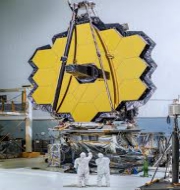NASA completes construction of James Webb Space Telescope
The National Aeronautics and Space Administration (NASA) has completed the construction of the James Webb Space Telescope (JWST) after more than 20 years of work.
JWST is the largest-ever space telescope is expected to launch in 2018 following the in-depth testing. It is bigger and more powerful than NASA’s operational Hubble Space Telescope.
Key Facts
- James Webb Space Telescope (JWST) is a space telescope optimized for observations in the infrared. It is a planned to be launched in 2018 on an Ariane 5 rocket from French Guiana.
- It is the formal successor to the Hubble Space Telescope and the Spitzer Space Telescope. After its launch it will be the premier observatory of the next decade.
- JWST has been named after James E. Webb, former administrator of NASA. It was formerly known as the Next Generation Space Telescope (NGST).
- It is an international collaboration between of about 17 countries including NASA, European Space Agency (ESA) and the Canadian Space Agency (CSA).
- It has a total area of 270 square feet composed of 18 hexagonal mirrors coated with beryllium and gold to collect the infrared readings. JWST has reflecting mirrors having diameter of 6.5m
- Hubble’s mirror has an area of just 48 square feet. Thus, JWST will be able to see much fainter objects than Hubble.
- Location: After its launch it will be positioned at the Earth–Sun L2 Lagrange Point (It is point of orbital equilibrium for blocking all its infrared interference).
- Four instruments of JWST: Cameras and spectrometers that are able to record extremely faint signals. NIRSpec having programmable microshutters for observation up to 100 objects simultaneously. Cryocooler for cooling the mid-infrared detectors.
- Applications: It will help in broad range of investigations across the fields of astronomy and cosmology. It will help to understand the origins of the universe, evolution of our own Solar System, search for signs of life on faraway planets. It can also analyze the atmospheres of exoplanets that pass in front of their stars

Month: Current Affairs - November, 2016


